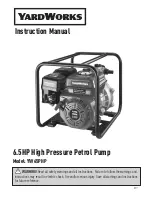
Instruction Handbook PFP-6hp-FL
- 12 -
C.E.T. Fire Pumps Mfg. This handbook is subject to change without notice,
Contact your local C.E.T. dealer or C.E.T. direct to ensure you have the latest version.
7.
Starting procedure
7.1.
Connect the outlet hose and make sure that there is a rubber seal on
the adapter and screw it tight. Verify the water source to be used is clear
of sand and/or small rocks, if sand enters your pump it would damage the
seal and wear rings, reducing useful life.
If starting the engine without
discharge hose, the floating pump will propel itself and go away.
WARNING: NEVER run the engine in an enclosed area. Exhaust
gas contains carbon monoxide, an odorless and potentially
deadly gas.
7.2.
Check the oil level.
7.3.
Check the fuel level.
7.4.
Connect the outlet hose and make sure that there is a rubber seal on
the adapter and screw it tight. Verify the water source to be used is clear
of sand and/or small rocks, if sand enters your pump it would damage the
seal and wear rings, reducing useful life.
7.5.
Place the floating pump on the water surface. Make sure there’s a
minimum depth of water to make to pump completely submerged and to
not suctioning the river bottom.
WARNING: The discharge hose will tend to straighten up when filled with
water. Make sure it won’t compromise the safety of your installation. Warn
the surrounding people before you start the pump. It is important that you
evaluate the trajectory of the hose to prevent incidents.







































